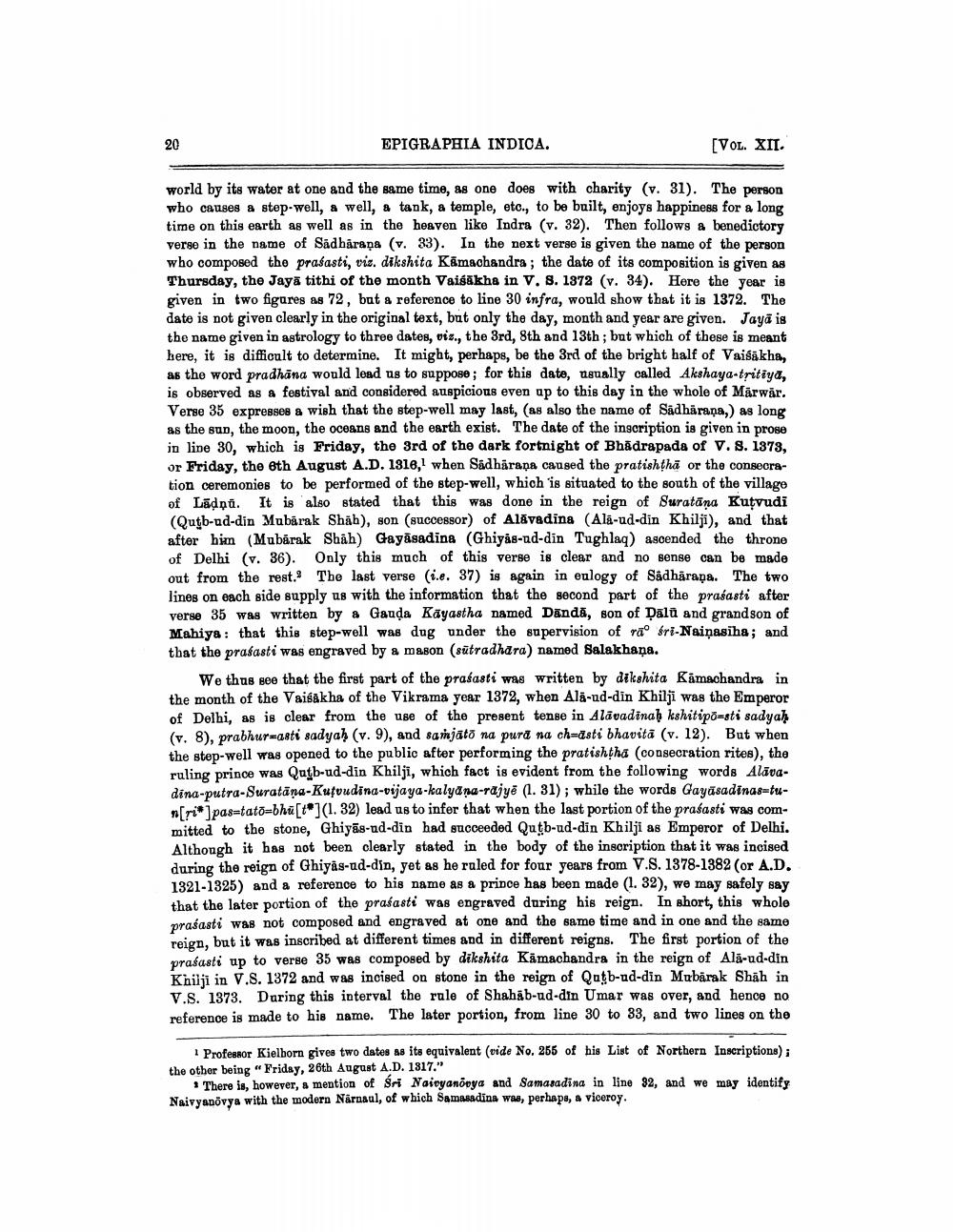________________
EPIGRAPHIA INDICA.
[VOL. XII.
world by its water at one and the same time, as one does with charity (v. 31). The person who causes a step-well, a well, a tank, a temple, etc., to be built, enjoys happiness for a long time on this earth as well as in the heaven like Indra (v. 32). Then follows a benedictory verse in the name of Sadhāraṇa (v. 33). In the next verse is given the name of the person who composed the prasasti, viz. dikshita Kamachandra; the date of its composition is given as Thursday, the Jayā tithi of the month Vaišākha in V. S. 1872 (v. 34). Here the year is given in two figures as 72, but a reference to line 30 infra, would show that it is 1372. The date is not given clearly in the original text, but only the day, month and year are given. Jaya is the name given in astrology to three dates, viz., the 3rd, 8th and 13th ; but which of these is meant here, it is difficult to determine. It might, perhaps, be the 3rd of the bright half of Vaisakha, as the word pradhāna would lead us to suppose; for this date, usually called Akshaya-tritiya, is observed as a festival and considered auspicious even ap to this day in the whole of Mārwar. Verse 35 expresses & wish that the step-well may last, (as also the name of Sadharaṇa,) as long as the sun, the moon, the oceans and the earth exist. The date of the inscription is given in prose in line 30, which is Friday, the 3rd of the dark fortnight of Bhādrapada of V. 8. 1373, or Friday, the eth August A.D. 1316, when Sádhāraṇa caused the pratishtha or the consecration ceremonies to be performed of the step-well, which is situated to the south of the village of Lādņu. It is also stated that this was done in the reign of Suratāna Kutvudi (Qutb-ud-din Mubarak Shah), son (successor) of Alāvadina (Ala-ud-din Khilji), and that after him (Mubarak Shah) Gayāsadina (Ghiyas-ud-din Tughlaq) ascended the throne of Delhi (v. 36). Only this much of this verse is clear and no sense can be made out from the rest. The last verse (ie. 37) is again in eulogy of Sadhāraṇa. The two lines on each side supply us with the information that the second part of the prasasti after verse 35 was written by a Gauda Kayastha named Danda, son of Dalū and grandson of Mahiya: that this step-well was dug under the supervision of ra fri-Naiņasiha; and that the prasasti was engraved by a mason (sūtradhara) named Salakhana.
We thus gee that the first part of the prasasti was written by dikshita Kamachandra in the month of the Vaisakha of the Vikrama year 1372, when Ala-ud-din Khilji was the Emperor of Delhi, as is clear from the use of the present tense in Alāvadinah kshitipo=sti sadyah (v. 8), prabhur=asti sadyah (v. 9), and samjato na pura na ch=asti bhavita (v. 12). But when the step-well was opened to the public after performing the pratishtha (consecration rites), the ruling prince was Qutb-ud-din Khilji, which fact is evident from the following words Alāvadina-putra-Suratäna-Kufvudina-vijaya-kalyana-rajye (1. 31); while the words Gayasadinastunfri pastatombhū[co](1. 32) lead us to infer that when the last portion of the prasasti was committed to the stone, Ghiyās-ud-din had succeeded Qutb-ud-din Khilji as Emperor of Delhi. Althongh it has not been clearly stated in the body of the inscription that it was incised during the reign of Ghiyas-ud-din, yet as he ruled for four years from V.S. 1378-1382 (or A.D. 1321-1325) and a reference to his name as a prince has been made (1. 32), we may safely say that the later portion of the prasasti was engraved during his reign. In short, this whole prasasti was not composed and engraved at one and the same time and in one and the same reign, but it was inscribed at different times and in different reigns. The first portion of the prasasti up to verse 35 was composed by dikshita Kamachandra in the reign of Ala-ud-din Khilji in V.S. 1372 and was incised on stone in the reign of Qutb-ud-din Mubarak Shah in V.S. 1373. During this interval the rule of Shahāb-ud-din Umar was over, and hence no reference is made to his name. The later portion, from line 30 to 33, and two lines on the
Professor Kielhorn gives two dates as its equivalent (vide No. 255 of his List of Northern Inscriptions); the other being "Friday, 26th August A.D. 1817."
There is, however, a mention of Sri Naivyanõvya and Samasadina in line 32, and we may identify Naivyanovya with the modern Narnaul, of which Samsudina was, perhaps, a viceroy.




